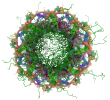3.1 SAS ?
3.1.1. Scattering profile ?
SAS data used in this integrative model was obtained from 1 deposited SASBDB entry (entries). Scattering data from solutions of biological macromolecules are presented as both log I(q) vs. q and log I(q) vs. log (q). The I(q) is the scattering intensity (preferably on an absolute scale in cm-1, but arbitrary units are accepted) and q is the modulus of the scattering vector (nm-1 or Å-1).
Scattering profile for SASDDD6.
3.1.2. Key experimental estimates ?
Molecular weight (MW) estimates from experiments and analysis: Theoretical MW can be compared to SAS-derived values using the forward scatter (I(0)) and the known concentration and partial specific volume of the scattering particle, or as estimated from the Porod volume and partial specific volume (Trewhella et al., 2017, Trewhella et al., 2023).
| SASDB ID | Chemical composition MW | Standard MW | Porod Volume/MW |
|---|---|---|---|
|
SASDDD6
|
65.3 kDa
|
Not available
|
1.59 nm³/kDa
|
Volume estimates from experiments and analysis: estimated volume can be compared to Porod volume obtained from scattering profiles.
| SASDB ID | Estimated Volume | Porod Volume | Specific Volume | Sample Contrast | Sample Concentration |
|---|---|---|---|---|---|
|
SASDDD6
|
Not available
|
104.90 nm³
|
Not available
|
Not available
|
16.10 mg/mL
|
3.1.3. Flexibility analysis ?
In a Porod-Debye plot, a clear plateau is observed for globular (partial or fully folded) domains, whereas flexible-modular, fully unfolded domains or extended/stiff rodshaped domains lack a discernible plateau (Rambo and Tainer 2013). A bell-shaped Kratky plot (q²I(q) vs. q) with a well-defined maximum is observed for compact/folded structures. For partially flexible/modular or extended structures the Kratky plot can show multiple maxima and/or an increase in intensity at higher q-values depending on the degree of flexibility and extension. Fully intrinsically disordered structures yield a Kratky plot that systematically increases with increasing q values and will be near linear for highly extended molecules. The dimensionless Kratky plot ((qRg)²I(q) vs. qRg) is useful for quantifying differences in shape and foldedness among scattering objects of different sizes (Trewhella et. al., 2023).
Flexibility analysis for SASDDD6.
3.1.4. Pair-distance distribution analysis ?
The the atom-pair distance distribution function (PDDF) or P(r) represents the distribution of distances between all pairs of atoms within the particle weighted by the respective scattering contrasts (Moore, 1980). The second moment of P(r) yields the radius of gyration (Rg), which is a measure of the overall size and shape of a macromolecule (i.e. the spatial distribution of volume elements). A protein with a smaller Rg is more compact than a protein with a larger Rg, provided both have the same molecular weight.
| SASDB ID | Software used | Dmax | Dmax error | Rg | Rg error |
|---|---|---|---|---|---|
|
SASDDD6
|
GNOM 5.0
|
14.400 nm
|
Not available
|
4.018 nm
|
Not available
|
P(r) for SASDDD6: The value of P(r) should be zero beyond r=Dmax.
3.1.5. Guinier analysis ?
The linearity of the Guinier plot (ln(q) vs. q²) at very-low angle (qRg < 1.3) is a sensitive indicator of the quality of the sample in relation to its homogeneity; a linear Guinier plot is a necessary but not sufficient demonstration that a solution contains monodisperse particles of the same size. Deviations from linearity can point to strong interference effects from particle attraction or repulsion, polydispersity of the samples, or improper background subtraction (Feigin et al., 2013). Residual difference plots and Pearson correlation coefficient determination (R²) are measures to assess quality of the linear fit to the Guinier region. A perfect fit has an R² value of 1. Residual values should be equally and randomly spaced around the horizontal axis with no evident systematic upward or downward curvature. Agreement between the P(r) and Guinier-determined Rg is a good measure of the self-consistency of the SAS profile.
| SASDB ID | Rg | Rg error | MW | MW error |
|---|---|---|---|---|
|
SASDDD6
|
3.89 nm
|
0.06 nm
|
Not available
|
Not available
|
The linearity of the Guinier plot is a sensitive indicator of the quality of the experimental SAS data; a linear Guinier plot is a necessary but not sufficient demonstration that a solution contains monodisperse particles of the same size. Deviations from linearity usually point to strong interference effects, polydispersity of the samples or improper background subtraction. Residual value plot and coefficient of determination (R2) are measures to assess linear fit to the data. A perfect fit has an R2 value of 1. Residual values should be equally and randomly spaced around the horizontal axis.
